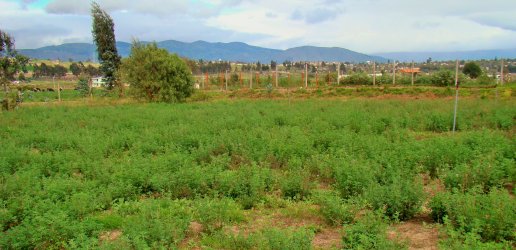Organic Agriculture
Rose Haven Farm is back but now in Ecuador. The property is not large, around 1.5 ha. or 3.4 acres but big enough for something. I have been here just over 2 years and when I arrived little had been done here. I had been told that various crops had been planted to add humus to the soil but the result has been minimal. In fact the soil is very sandy, drains quickly, and for much of the year, the climate is dry, although rarely reaches freezing. So what have I been doing?
I have long been interested in trying to farm without a lot of chemicals, organically if possible. And in permaculture where we don’t have to till the soil very year. So this is what we have done to date.

The next venture came from Isabel as she wanted to start a cuy (guinea pig) operation. Her mother-in-law bought her a cuy house and later she added a second. Then her husband brought back some male cuyes from Peru as these are genetically larger than those found in 
Then I had always wanted to have a little lavender operation and since the terrain & climate is dry much like Provence, I thought this might be possible. So I selected a site near my entrance and went to a 
When I had enough plants blooming Isabel and I made some products and showcased them at our local market in Poalo. She and I made decorative Lavendin items like wands, swags and wreaths, as well as .jpg) sashays for drawers while I made some lemon loaves. I intend to keep this going so last August I made cuttings and we now have enough rooted to start transplanting them to increase my production. I will continue to take cuttings, but may buy more. In addition I am thinking getting a plant import licence would be worth investigating, then I can buy “real’ lavender varieties. All my efforts to propagate seed from both Canada and Spain have failed.
sashays for drawers while I made some lemon loaves. I intend to keep this going so last August I made cuttings and we now have enough rooted to start transplanting them to increase my production. I will continue to take cuttings, but may buy more. In addition I am thinking getting a plant import licence would be worth investigating, then I can buy “real’ lavender varieties. All my efforts to propagate seed from both Canada and Spain have failed.

.JPG)
I did have a compost bin built and we have already been able to contribute some of this to the vegetable garden. Separately is the issue of water. This is a frequently dry rural area served by an open agricultural water canal. I am eligible for water on a rotational basis but the hours are limited. And site distribution is not easy. I also have a second water option which is water delivered by underground pipes. To this I have set up a sprinkler system but unfortunately this 
.jpg) Currently we are putting in a windbreak on the south side as this faces direct strong winds mainly in August and September. We have selected acacia trees as these seem to grow fast here and need no special care.
Currently we are putting in a windbreak on the south side as this faces direct strong winds mainly in August and September. We have selected acacia trees as these seem to grow fast here and need no special care.
As money and time permits, I have ideas for more projects – a chicken coop for eggs, beehive for pollination and perhaps lavender honey, quails (cute small eggs), fish in my new pond when completed, more of the local agaves for fibre for textile products and even a kind of liquor similar to Tequila. I always have fun exploring options and so, keep tuned.